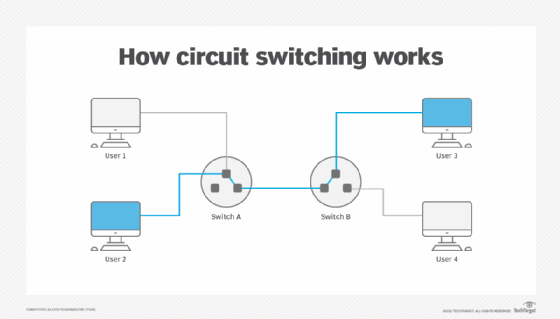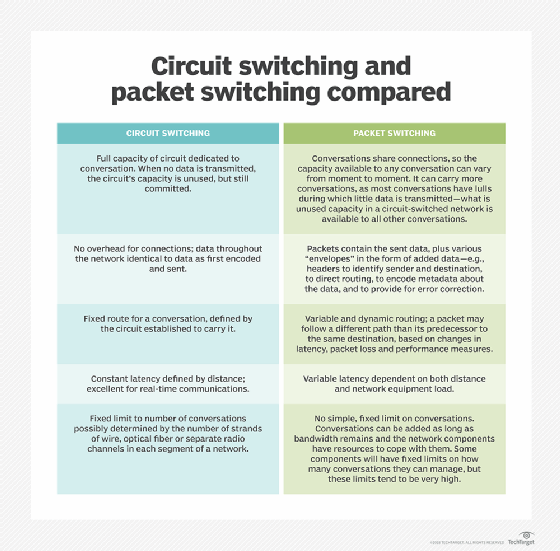circuit switching
What is circuit switching?
Circuit switching is a type of network configuration in which a physical path is obtained and dedicated to a single connection between two endpoints in the network for the duration of a dedicated connection. Ordinary voice phone service uses circuit switching. This reserved circuit is used for the duration of a call. As long as the call lasts, the circuit cannot be used for anything else.
In circuit switching, the bandwidth and data transmission rate are fixed. Circuit switching is connection-oriented, meaning a physical connection between hosts is required for it to work.
What is circuit switching used for?
Examples of where circuit switching is used include the following:
- Continuous connections. Circuit switching is used for connections that must be continuous for long periods of time, such as long-distance communication. Traditional telephone systems -- i.e., landlines -- are an example of a technology that uses circuit switching.
- Dial-up network connections. When computers connect to the internet via a dial-up service, it uses the public switched network. With dial-up, Internet Protocol (IP) data packets are carried over a circuit-switched telephone network.
- Optical circuit switching. Data center networks also use circuit switching. Optical circuit switching is used to scale traditional data centers and meet growing bandwidth requirements.
What are the phases of circuit switching?
These are the three main phases of circuit switching:
- Connection establishment. Also called call setup, this phase establishes a dedicated circuit between two communicating endpoints. The parties send a message back and forth acknowledging the established connection. There are usually intermediate links or switches between the two parties.
- Data transfer. Data -- usually voice -- is transmitted from the source to the destination. The connection remains intact for the length of the interaction.
- Connection relinquishment. This is also called the teardown phase. At the end of the interaction, one of the two endpoints sends a message initiating a disconnection. The communication path, including the intermediate links, is terminated.

How do packet-switched and circuit-switched networks differ?
The main difference between packet-switched vs. circuit-switched networks is that circuit-switched networks are connection-oriented and packet-switched networks are connectionless. Voice over IP is a telephony protocol that uses packet switching.
In packet switching, information is broken into data packets that are sent through the network independently of one another. There is no fixed, dedicated channel as there is in circuit switching. Instead, packets are sent over a network that other hosts share. Transmission also is not continuous.
Some packet-switched networks, such as X.25, have switched virtual circuits. Virtual circuit switching establishes a dedicated connection using packet-switching technology. A virtual circuit-switched connection is a dedicated, logical connection that enables multiple virtual circuit connections to share a physical path.
Packet switching does not reserve all the bandwidth for a connection in advance. Because of that, it is more energy-efficient. One drawback to packet switching is that transmission quality can be poor because there can be lost or dropped packets.

What are the advantages of circuit-switched networks?
The advantages of circuit-switched networks include the following:
- Dedicated channel. Circuit-switched networks reserve a dedicated communications channel circuit that only the two endpoints can access.
- Reliable. A dedicated circuit between two hosts for the duration of that connection decreases the potential for data loss or other reliability problems.
- Security. Circuit-switched networks are more secure than packet-switched networks due to having only two communicating parties on a dedicated circuit.
- Quality. Once a connection is established, this type of network generally has a consistent connection quality without delays in data flow.
What are the disadvantages of circuit-switching?
The drawbacks of using a circuit-switched network include the following:
- Limited use. Circuit-switched networks can only be used for voice communication and aren't available for other types of connections.
- Inefficient. When a circuit is continuously reserved even when it's not in use, network bandwidth is wasted.
- Inflexible. A dedicated channel can only be used for circuit-switched network traffic and nothing else. And, if there aren't enough dedicated channels, calls can fail.
- Higher cost. A dedicated channel costs more per use.
- Latency. Extra time is required to establish a connection before data is sent.
The takeaway
Circuit switching is the foundation of traditional telecommunication systems and landlines. Packet switching is the basis of the modern internet. Each has advantages and disadvantages. And, sometimes, they overlap -- for example, when a packet switching network emulates circuit-switching technology and establishes a connection-oriented method of data transfer.
Today, the internet and most phone services rely on packet switching. But most legacy networks were designed for circuit-switched traffic. New optical routing architecture could help close this gap.







